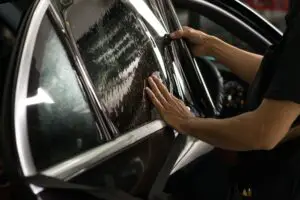In an ideal world, you would be allowed to tint your car windows in whatever darkness and color you want; however, many states in the United States require you to have a certain amount of VLT for safety reasons.
Hawaii window tint laws have kept this VLT threshold at a solid 35% for most windows of Sedans and SUVs while allowing some windows to have any level of darkness.
Limits on metallic and mirrored appearances have also been set in place, along with restrictions on the windshield.
If you want to know all of these rules in-depth, then read this article, as I will be explaining all of them in great detail and going over any major concerns.
Table of Contents
- 1 How Much Tint Darkness Is Legal In Hawaii?
- 2 Window Tint Reflection And Tint Colors
- 3 Medical Exemption Of Window Tint Laws In Hawaii
- 4 Get A Certified Sticker From The Company
- 5 Other Window Tint Law Rules And Regulations In Hawaii
- 6 Cost Of Car Window Tint In Hawaii
- 7 Frequently Asked Questions
- 8 Conclusion
How Much Tint Darkness Is Legal In Hawaii?

VLT is the amount of light that needs to get inside via your windows, and apart from a few windows that do not have any restrictions, the baseline requirement for VLT is 35%.
Tint Darkness Limit For SUVs And Vans
The window tinting laws for SUVs and vans are a bit more relaxed than those for Sedans.
This is primarily because the windows that do not have any restrictions regarding their tint film’s VLT are present here.
Starting with the windshield, Hawaii requires that you do not use a reflective tint, and any tint that you do use is limited to the top 4 inches of the windshield itself.
Next up are the front seat side windows, which receive most of the instructions. These windows require you to use tinting films with at least 35% VLT.
These requirements slowly fade away for the remaining windows, like the back seat side windows, and the rear windows can use any amount of darkness, leaving it up to the owner to decide how dark they want these windows to be.
Tint Darkness Limit For Sedans
Sedans follow a similar structure to sports utility vehicles but have more restrictions placed upon them.
1. Front Windshield
The front-seat side windows allow at least 35% light inside the vehicle. This is a trend that the other windows also follow.
2. Front Seat Side Windows
The windshield of sedans follows the same rule as above, requiring you to use non-reflective tints, which are limited to the first 4 inches of the windshield from the top.
3. Rear Window
Finally, you get a similar case for the rear window, which requires a minimum of 35% VLT.
4. Back Seat Side Windows
The back seat side windows also require you to have 35% VLT, making it such that all windows of sedans have a 35% VLT requirement.
Window Tint Reflection And Tint Colors
- On the topic of colors and reflection, you will get a set of rules that parallel many other states.
- Mirrored appearances of the tints on any windows are not allowed.
- The same is the case for metallic aesthetics.
- There is no such color restrictions placed in the state of Hawaii.
- This means that you can have whatever color you want without restriction from the law.
Medical Exemption Of Window Tint Laws In Hawaii

While many of us can follow the above laws, it can be quite difficult for some groups of people as suffering from certain conditions can render them unable to withstand the sun’s rays for longer periods.
These conditions make it quite difficult to follow the rules set by the state of Hawaii when it comes to the window tint laws.
This issue is only further enhanced by the fact that Hawaii does not allow any sort of medical exemptions for people of any kind.
While other states would allow you some sort of medical exemptions, there is no such case here in Hawaii which is quite sad considering there are many people who could benefit from being medically exempt.
If you cannot make do with the baseline 35% VLT requirements, you are out of luck. The next topic only heightens this level of inconvenience in the article.
Get A Certified Sticker From The Company
Some states require you to show the legibility of your tint films by having a certificate or sticker in/on your car at all times.
This is also extended to the manufacturers of the tints, who have to provide you with a certificate that lets you know that their tint follows the standard that the state has set.
In Hawaii, there are no such requirements, meaning people are not required to show the legibility of their tints to show if it is legal or not, and the manufacturers are not required to certify the film.
Other Window Tint Law Rules And Regulations In Hawaii
Now I will go over any other laws that may affect window tints in Hawaii, so make sure to read carefully.
- If you have your back window tinted, you are legally required to have dual side mirrors.
- The state of Hawaii allows a tint variance of 6%, meaning you must be at least 6% close to the VLT requirements of the state. It is recommended you stick to the base of 35% VLT. The lowest you can go to is then 29% VLT.
- You are not required to have any sticker to show the legibility of your window tints.
- You are not required to carry any form of certification related to your window tints.
- There are no medical exemptions given in the state of Hawaii.
Cost Of Car Window Tint In Hawaii
Tinting your windows in Hawaii is no cheap venture. The cheapest you can usually find is $200 at the least.
Normal tints for your windows can start from this price tag and extend up to $500, which is a lot for standard window tints.
If you want better tints that have more quality, durability, and a lifetime warranty, you will need to give anything over $700, which is a lot.
This price will only rise if you decide to opt for certain colors or apply them to more and more windows.
Frequently Asked Questions
Q1. Is 15% Tint Legal In Hawaii?
15% tints are legal in Hawaii, but only if used in the rear and back seat side windows of your sports utility vehicles and vans.
Since all the sedans must have at least 35% VLT in their windows, it would be illegal to use them on a sedan.
Q2. Are 5% Tints Legal In Hawaii?
Considering the information given in the above answer, it is safe to say that 5% tints are also illegal in most cases, with them being legal only if used in the back seat side windows and the rear windows of SUVs and vans.
Q3. Is Limo Tint Legal In Hawaii?
Limo tints are usually very dark and fall below 7% VLT. This makes them less than legal for most windows in Hawaii.
However, they can be applied to your Sports Utility Vehicles and vans but only on the back seat side and rear windows.
Q4. Can I Get Pulled Over For Tint In Hawaii?
In the vent that a police officer sees you tints and thinks they are not following the state’s requirements, they can and will pull you over.
They will then check your tint darkness and act accordingly, so make sure you follow the rules and not get pulled over.
Q5. How Much Is A Tint Ticket In Hawaii?
If you are a normal vehicle owner, a tint ticket can cost you anything, starting from $250 to $500.
However, for businesses, the price is doubled, and the ticket fee can range anything from $500 to $1000, so make sure you have all the rules at your fingertips.
Conclusion
Hawaii tint laws are much like the ones from various other states, with low VLT requirements for all windows of most vehicles and the fact that manufacturers and the owners of tinted vehicles are required to show any form of certification.
The things to be upset about are the heavy fines and the fact that people who should be medically exempt are shown no sympathy and not given any way to avoid these laws.
Regardless of whether you have a condition, you will have to follow the rules set by the state or risk getting fined.

I am Tahir Azam, and I have been writing amazing articles for TaxiHack for as long as I can remember. I know everything that is to know when it comes to automobiles and is always on top of industry news and developments. While I am not an expert by any means, I pride myself on knowing the ins and outs of many different problems and, of course, their solutions. The articles on our website are some of the best and well-researched content that you will find, and I spend countless hours making sure this remains to be true. This is why I ask you to take your time out and read some of my articles, especially if you find a topic that resonates with you or is something you are looking into. This way, you will find the perfect mix of information and tips on your desired topic. Learn more about Tahir.



